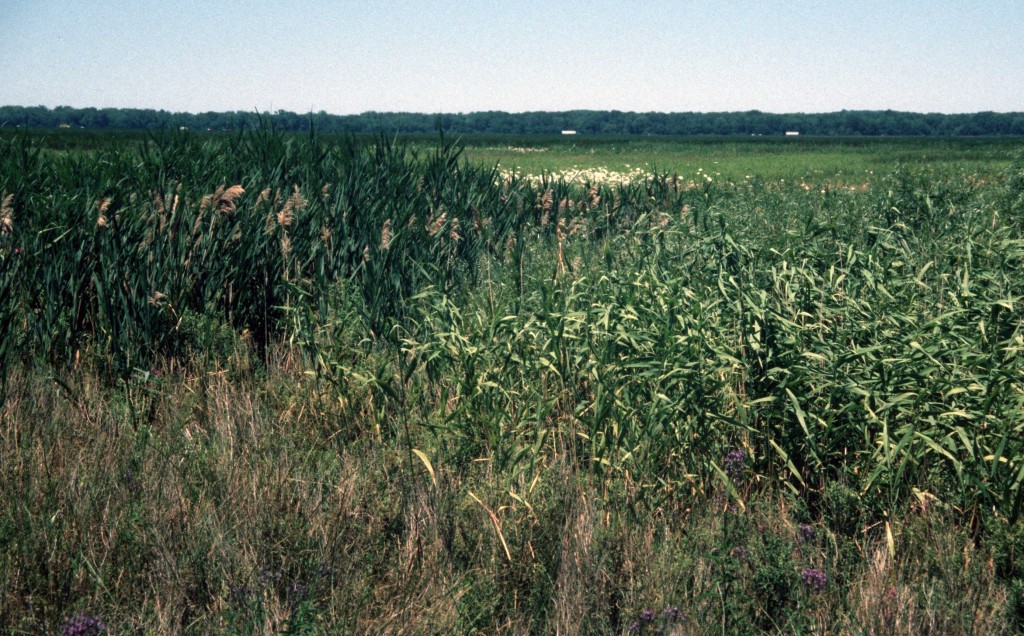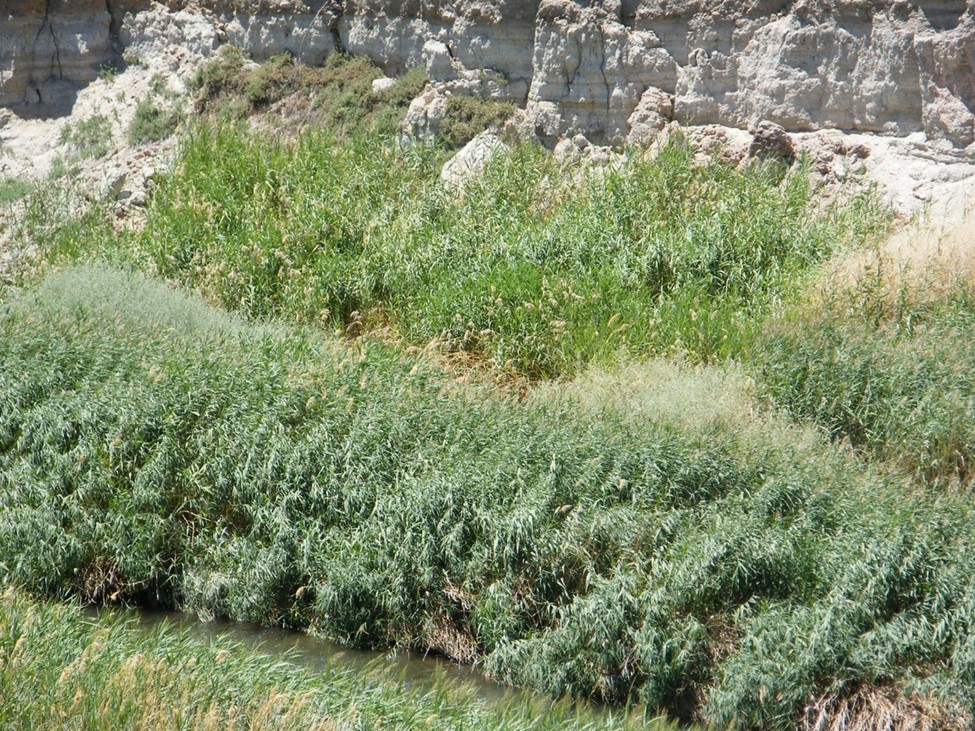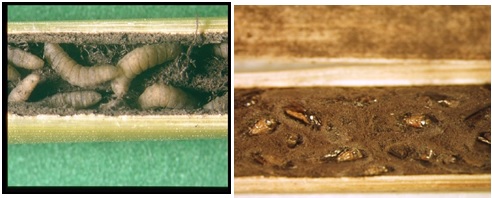Kristin Saltonstall, Smithsonian Tropical Research Institute, Panama City, Panama
Bernd Blossey, Dept. of Natural Resources, Cornell University, Ithaca, NY
Published October 2014 (updated: April 2022)
The lack of evidence for hybridization between native and introduced Phragmites australis in North America has puzzled researchers for over a decade. The two lineages are found together over the entire range of native P. australis subsp. americanus and have overlapping flowering periods, yet only isolated cases of hybrids have been identified. How is this possible and do hybrids pose a threat?

Introduced and Native Phragmites clones side-by-side at Montezuma National Wildlife Refuge, Seneca Falls, NY. Photo courtesy of Kristin Saltonstall
Threats of Hybridization
Hybridization between plant species is quite common and can have many effects, including creating new species, generating new phenotypic variants, stimulating invasiveness, or little impact if a hybrid is sterile and has a low competitive ability. If introgression, or repeated backcrossing, occurs, one of the parental species may become genetically “swamped” by the introgressing species, or if introgression is extensive in both directions, hybrid swarms may develop and potentially outcompete both parental species.
In this case, hybridization between the native and introduced lineages of Phragmites is of concern as it could impact native plants by causing a loss of genetically adapted local native populations or create more vigorous plants that outcompete natives, thereby creating a new aggressive Phragmites lineage. Their existence may also make ongoing research into biocontrol organisms for Phragmites more complicated. However, it may also be that hybrid Phragmites poses little threat to native plant communities.

Phragmites along the Las Vegas Wash, NV. Hybrid Phragmites (introduced maternal parent) are seen in the foreground with Native Phragmites (haplotype H) in the background. Photo credit: Kristin Saltonstall
Evidence for Phragmites hybrids
To date, genetic studies by multiple researchers have shown little evidence for Phragmites hybrids occurring at field sites across North America (Saltonstall 2003, 2010, Kettenring & Mock 2012, Douhovnikoff & Hazelton 2014, Albert et al. 2015; McCormick et al. 2016; Melchior & Weaver 2016, Stabile et al. 2016, Tippery et al. 2020). However, hybrids have been created in the laboratory (Meyerson et al. 2010), are suspected to occur in some locations (Paul et al. 2010, Wu et al. 2015), and have been confirmed in both Seneca Falls, NY (Saltonstall et al. 2014) and in Las Vegas, NV (Saltonstall et al. 2016). At Seneca Falls, the plants were first suspected of being hybrids by their intermediate morphological characteristics, including stem characteristics more indicative of native plants and herbivore communities more characteristic of introduced Phragmites. Genetic tests showed that the maternal parent of these plants is introduced and that they are likely first-generation hybrids. Although several clones were identified at the site, all were genetically identical, indicating that they had likely been spread from clonal fragments rather than from seed. In contrast, in Las Vegas where hybrids form extensive stands along the Las Vegas Wash, two types of hybrid plants, having either native or introduced maternal parents, have been identified and while clonal spread is surely occurring due to human and water transport, not all plants are clones. Both types of hybrids had stem densities and morphologies that were similar to native Phragmites plants, which also form widespread and dense monocultures along the Wash (Saltonstall et al. 2016). Germination trials with seeds from these hybrids suggest that while their seed output may be higher, hybrids have lower germination rates than either native or introduced plants from the southwest. However, all hybrids easily resprouted from rhizome fragments suggesting that vegetative dispersal poses a real threat to the spread of these hybrid plants outside of the Las Vegas Wash region (Williams et al. 2019)
Morphologically, hybrid plants may be difficult to identify due to a blending of characters commonly observed in the native and introduced lineages. The hybrid plants found in Seneca Falls, NY looked more native with long ligules and glossy stems. In spring most leaf sheaths remained on overwintering stems but were only loosely attached and had no firm connection to the stem (like native leaf sheaths appear in the fall, before detaching completely). However, patterns of insect attack were more like introduced plants, suggesting that the internal chemistry and tissue characteristics of these hybrids differs from natives. The introduced gall midge, Lasioptera hungarica, was abundant on the hybrid specimens although it has previously been found to only attack introduced plants. Despite success in easy propagation of native and introduced plants using rhizome fragments, the Blossey lab has not been able to grow hybrid plants from rhizome fragments in a common garden. This has limited our ability to further study them but they persist at the field site.

Phragmites internode filled with black mycelium and larvae (left) and pupae (right) of Lasioptera hungarica. Photos courtesy of Bernd Blossey
Cautions
Although we now know that crosses between native and introduced Phragmites plants can form viable hybrid offspring, we know little about the reproductive ability of these plants, how competitive they are, and whether or not they are likely to spread further. In both New York and Las Vegas we found first-generation hybrids that had spread clonally, likely due to management actions on the site. Our understanding of how environmental conditions may facilitate their spread into surrounding areas in the future is limited and regional climatic and habitat differences make it difficult to generalize this risk.
Further, as there are regional differences in native Phragmites plants across North America, it may be that hybrids are more likely to develop and establish in some locations than others. Compatibility between the introduced and native lineages could vary with a variety of conditions, including temperature, rainfall, and daylength, making predictions of where and when hybrids are most likely to develop extremely difficult. Morphological identification of hybrids is also likely to remain difficult, as characters may vary between crosses of the different native haplotypes and the introduced lineage. As always, we would like to emphasize the need for looking at multiple characters when attempting to identify the parental lineage of Phragmites plants, as single characters (particularly height, stem density, and inflorescence characteristics alone) are poor predictors of native or introduced status.
What can be done?
- Where preservation of native communities is a management goal, remove all introduced Phragmites to minimize opportunities for hybridization with natives
- If you suspect you have a hybrid plant, send it out for genetic testing to confirm its status (both cpDNA haplotyping and microsatellite analysis)
- If hybrids are detected, remove them from a site immediately, taking care to prevent rhizome fragments from reestablishing
- If removal is not possible, mow plants before flowering initiates to prevent further crosses, backcrossing, and seed dispersal. Make sure to remove and destroy all cut stems to prevent spread via stem sprouts.
Literature cited:
Albert, A., J. Brisson, F. Belzile, J. Turgeon, and C. Lavoie. 2015. Strategies for a successful plant invasion: the reproduction of Phragmites australis in north- eastern North America. Journal of Ecology 103: 1529–1537
Douhovinikoff, V and ELG Hazelton. 2014. Clonal growth: Invasion or stability? A comparative study of clonal architecture and diversity in native and introduced lineages of Phragmites australis (Poaceae). American Journal of Botany 101(9): 1577-1584. doi: 10.3732/ajb.1400177
Kettenring, KM and KE Mock. 2012. Genetic diversity, reproductive mode, and dispersal differ betweeen the cryptic invader, Phragmites australis, and its native conspecific. Biological Invasions 14: 2489-2504.
McCormick, M. K., H. E. Brooks, and D. F. Whigham. 2016. Microsatellite analysis to estimate realized dispersal distance in Phragmites australis. Biological Invasions 18: 2497–2504.
Melchior P.P.and R. Weaver. 2016. https://www.reabic.net/journals/bir/2016/Issue2.aspx Eurasian haplotype M Phragmites australis (Cav.) Trin. ex Steud., 1841 invasion in Minnesota, USA: a baseline for further monitoring in the upper Mississippi watershed (pp 59-65)
Meyerson, LA, DV Viola, and RN Brown. 2010. Hybridization of invasive Phragmites australis with a native subspecies in North America. Biological Invasions 12: 103-111.
Paul, JN Vachon, CJ Garroway, and JR Freeland. 2010. Molecular data provide strong evidence of natural hybridization between lineages of Phragmites australis in North America. Biological Invasions 12: 2967-2973.
Saltonstall, K. 2003. Microsatellite variation within and among North American lineages of Phragmites australis. Molecular Ecology 12(7): 1689-1702.
Saltonstall, K. 2011. Remnant native Phragmites australis maintains genetic diversity despite multiple threats. Conservation Genetics. 12: 1027-1033. doi: 10/1007/s10592-011-0205-1
Saltonstall, K. HE Castillo, and B. Blossey. 2014. Confirmed field hybridization of native and introduced Phragmites australis (Poaceae) in North America. American Journal of Botany 101(1): 1–5. doi:10.3732/ajb.1300298
Saltonstall, K., Lambert, A.M. & Rice, N. What happens in Vegas, better stay in Vegas: Phragmites australis hybrids in the Las Vegas Wash. Biol Invasions 18, 2463–2474 (2016). https://doi.org/10.1007/s10530-016-1167-5
Stabile, J., D. Lipus, L. Maceda, M. Maltz, N. Roy, and I. Wirgin. 2016. Microsatellite DNA analysis of spatial and temporal population structuring of Phragmites australis along the Hudson River Estuary. Biological Invasions 18: 2517–2529.
Tippery, N.P., Pesch, J.D., Murphy, B.J. et al. Genetic diversity of native and introduced Phragmites (common reed) in Wisconsin. Genetica 148, 165–172 (2020). https://doi.org/10.1007/s10709-020-00098-z
Williams, J., Lambert, A. M., Long, R., and Saltonstall, K.. 2019. Does hybrid Phragmites australis differ from native and introduced lineages in reproductive, genetic, and morphological traits? American Journal of Botany 106( 1): 29– 41.
Wu, C.A., Murray, L.A. and Heffernan, K.E. (2015), Evidence for natural hybridization between native and introduced lineages of Phragmites australis in the Chesapeake Bay watershed. American Journal of Botany, 102: 805-812. https://doi.org/10.3732/ajb.1500018
For more information, ask questions through the comments section below or contact Kristin Saltonstall at SaltonstallK@si.edu
